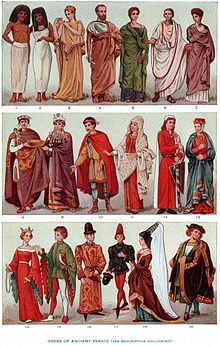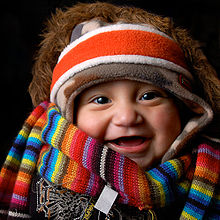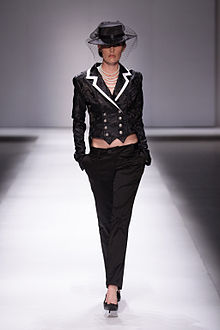- Clothing
-
Clothing refers to any covering for the human body that is worn. The wearing of clothing is exclusively a human characteristic and is a feature of nearly all human societies. The amount and type of clothing worn depends on functional considerations (such as a need for warmth or protection from the elements) and social considerations.
Physically, clothing serves many purposes; it can serve as protection from the elements, it can enhance safety during hazardous activities such as hiking and cooking, by providing a barrier between the skin and the environment. Clothes can protect humans from insect bites or splinters. Further, clothes can regulate temparature and provide a hygienic barrier, keeping toxins away from the body and limiting the transmission of germs. Clothing also provides protection from harmful UV radiation.
Clothing performs a range of social and cultural functions, such as individual, occupational and sexual differentiation, and social status.[1] A uniform, for example, may identify civil authority figures, such as police and military personnel, or it may identify team, group or political affiliations.
In many societies, norms about clothing reflect standards of modesty, religion, gender, and social status. Clothing may also function as a form of adornment and an expression of personal taste or style.
Clothing can and has in history been made from a very wide variety of materials. Materials have ranged from leather and furs, to woven materials, to elaborate and exotic natural and synthetic fabrics.
Not all body coverings are regarded as clothing. Articles carried rather than worn (such as purses), worn on a single part of the body and easily removed (scarves), worn purely for adornment (jewelry), or those that serve a function other than protection (eyeglasses), are normally considered accessories rather than clothing,[citation needed] as are footwear and hats.
Contents
Functions
The primary function of clothing is to improve the comfort of the wearer. In hot climates, clothing provides protection from sunburn or wind damage, while in cold climates its thermal insulation properties are generally more important. Shelter usually reduces the functional need for clothing. For example, coats, hats, gloves, shoes, socks, and other superficial layers are normally removed when entering a warm home, particularly if one is residing or sleeping there. Similarly, clothing has seasonal and regional aspects, so that thinner materials and fewer layers of clothing are generally worn in warmer seasons and regions than in colder ones.
Clothing protects people against many things that might injure the uncovered human body. Clothes act as protection from the elements, including rain, snow and wind and other weather conditions, as well as from the sun. However, if clothing is too sheer, thin, small, tight, etc., the protection effect is minimized. Clothes also reduce the level of risk during activity, such as work or sport. Clothing at times is worn as protection from specific environmental hazards, such as insects, noxious chemicals, weapons, and contact with abrasive substances. Conversely, clothing may protect the environment from the clothing wearer, as with doctors wearing medical scrubs.
Humans have shown extreme inventiveness in devising clothing solutions to environmental hazards. Some examples include: space suits, air conditioned clothing, armor, diving suits, swimsuits, bee-keeper gear, motorcycle leathers, high-visibility clothing, and other pieces of protective clothing. Meanwhile, the distinction between clothing and protective equipment is not always clear-cut, since clothes designed to be fashionable often have protective value and clothes designed for function often consider fashion in their design.
The wearing of clothes also has social implications. They are worn to cover those parts of the body which social norms require to be covered, and act as a form of adornment, as well as other social purposes.
Scholarship
Although dissertations on clothing and its functionality are found from the 19th century as colonising countries dealt with new environments,[2] concerted scientific research into psycho-social, physiological and other functions of clothing (e.g. protective, cartage) occurred in the first half of the 20th century, with publications such as Flugel's Psychology of Clothes in 1930,[1] and Newburgh's seminal Physiology of Heat Regulation and The Science of Clothing in 1949.[3] By 1968, the field of environmental physiology had advanced and expanded significantly, but the science of clothing in relation to environmental physiology had changed little.[4] While considerable research has since occurred and the knowledge-base has grown significantly, the main concepts remain unchanged, and indeed Newburgh's book continues to be cited by contemporary authors, including those attempting to develop thermoregulatory models of clothing development.[5]
Cultural aspects
Gender differentiation
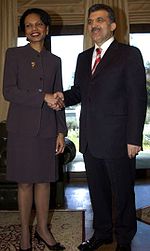 Former US Secretary of State Condoleezza Rice and Turkish President Abdullah Gül both wearing Western-style business suits.
Former US Secretary of State Condoleezza Rice and Turkish President Abdullah Gül both wearing Western-style business suits.
In most cultures, gender differentiation of clothing is considered appropriate for men and women. The differences are in styles, colors and fabrics.
In Western societies, skirts, dresses and high-heeled shoes are usually seen as women's clothing, while neckties are usually seen as men's clothing. Trousers were once seen as exclusively male clothing, but are nowadays worn by both genders. Male clothes are often more practical (that is, they can function well under a wide variety of situations), but a wider range of clothing styles are available for females. Males are typically allowed to bare their chests in a greater variety of public places. It is generally acceptable for a woman to wear traditionally male clothing, while the converse is unusual.
In some cultures, sumptuary laws regulate what men and women are required to wear. Islam requires women to wear more modest forms of attire, usually hijab. What qualifies as "modest" varies in different Muslim societies; however, women are usually required to cover more of their bodies than men are. Articles of clothing worn by Muslim women for purposes of modesty range from the headscarf to the burqa.
Men may sometimes choose to wear men's skirts such as togas or kilts, especially on ceremonial occasions. Such garments were (in previous times) often worn as normal daily clothing by men. Compared to men's clothing, women's clothing tends to be more attractive, often intended to be looked at by men.[6]
Social status
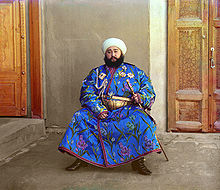 Alim Khan's bemedaled robe sends a social message about his wealth, status, and power
Alim Khan's bemedaled robe sends a social message about his wealth, status, and power
In some societies, clothing may be used to indicate rank or status. In ancient Rome, for example, only senators were permitted to wear garments dyed with Tyrian purple. In traditional Hawaiian society only high-ranking chiefs could wear feather cloaks and palaoa or carved whale teeth. Under the Travancore Kingdom of Kerala, (India), lower caste women had to pay a tax for the right to cover their upper body. In China, before the establishment of the republic, only the emperor could wear yellow. History provides many examples of elaborate sumptuary laws that regulated what people could wear. In societies without such laws, which includes most modern societies, social status is instead signaled by the purchase of rare or luxury items that are limited by cost to those with wealth or status. In addition, peer pressure influences clothing choice.
Religion
See also: Category:Religious vesture Nicolas Trigault, a Flemish Jesuit, in Ming-style Confucian scholar costume, by Peter Paul Rubens. This drawing shows a fusion between West and East also Christianity and Confucianism.
Nicolas Trigault, a Flemish Jesuit, in Ming-style Confucian scholar costume, by Peter Paul Rubens. This drawing shows a fusion between West and East also Christianity and Confucianism.
 Muslim men traditionally wear white robes and a cap during prayers
Muslim men traditionally wear white robes and a cap during prayers
Religious clothing might be considered a special case of occupational clothing. Sometimes it is worn only during the performance of religious ceremonies. However, it may also be worn everyday as a marker for special religious status.
For example, Jains and Muslim men wear unstitched cloth pieces when performing religious ceremonies. The unstitched cloth signifies unified and complete devotion to the task at hand, with no digression.[citation needed] Sikhs wear a turban as it is a part of their religion.
The cleanliness of religious dresses in Eastern Religions like Hinduism, Sikhism, Buddhism, Islam and Jainism is of paramount importance, since it indicates purity.
Clothing figures prominently in the Bible where it appears in numerous contexts, the more prominent ones being: the story of Adam and Eve, Joseph's cloak, Judah and Tamar, Mordecai and Esther. Furthermore the priests officiating in the Temple had very specific garments, the lack of which made one liable to death.
In Islamic traditions, women are required to wear long, loose, non-transparent outer dress when stepping out of the home. Women of higher status throughout history have worn more modest clothes. This dress code was democratic (for all women regardless of status) & protection from the scorching sun. The Quran says this about husbands & wives: "...They are clothing/covering (Libaas) for you; and you for them." (Chapter 2:187)
Jewish ritual also requires rending of one's upper garment as a sign of mourning. This practice is found in the Bible when Jacob hears of the apparent death of his son Joseph.[7]
Origin and history
Main article: History of clothingSee also: History of Western fashion and Category:History of clothingFirst recorded use
According to archaeologists and anthropologists, the earliest clothing likely consisted of fur, leather, leaves, or grass that were draped, wrapped, or tied around the body. Knowledge of such clothing remains inferential, since clothing materials deteriorate quickly compared to stone, bone, shell and metal artifacts. Archeologists have identified very early sewing needles of bone and ivory from about 30,000 BC, found near Kostenki, Russia in 1988.[8] Dyed flax fibers that could have been used in clothing have been found in a prehistoric cave in the Republic of Georgia that date back to 36,000 BP.[9][10]
Scientists are still debating when people started wearing clothes. Ralf Kittler, Manfred Kayser and Mark Stoneking, anthropologists at the Max Planck Institute for Evolutionary Anthropology, have conducted a genetic analysis of human body lice that suggests clothing originated quite recently, around 107,000 years ago. Body lice is an indicator of clothes-wearing, since most humans have sparse body hair, and lice thus require human clothing to survive. Their research suggests the invention of clothing may have coincided with the northward migration of modern Homo sapiens away from the warm climate of Africa, thought to have begun between 50,000 and 100,000 years ago. However, a second group of researchers using similar genetic methods estimate that clothing originated around 540,000 years ago (Reed et al. 2004. PLoS Biology 2(11): e340). For now, the date of the origin of clothing remains unresolved.[citation needed]
Making clothing
Some human cultures, such as the various people of the Arctic Circle, traditionally make their clothing entirely of prepared and decorated furs and skins. Other cultures supplemented or replaced leather and skins with cloth: woven, knitted, or twined from various animal and vegetable fibers.
Although modern consumers may take the production of clothing for granted, making fabric by hand is a tedious and labor intensive process. The textile industry was the first to be mechanized — with the powered loom — during the Industrial Revolution.
Different cultures have evolved various ways of creating clothes out of cloth. One approach simply involves draping the cloth. Many people wore, and still wear, garments consisting of rectangles of cloth wrapped to fit — for example, the dhoti for men and the sari for women in the Indian subcontinent, the Scottish kilt or the Javanese sarong. The clothes may simply be tied up, as is the case of the first two garments; or pins or belts hold the garments in place, as in the case of the latter two. The precious cloth remains uncut, and people of various sizes or the same person at different sizes can wear the garment.
Another approach involves cutting and sewing the cloth, but using every bit of the cloth rectangle in constructing the clothing. The tailor may cut triangular pieces from one corner of the cloth, and then add them elsewhere as gussets. Traditional European patterns for men's shirts and women's chemises take this approach.
Modern European fashion treats cloth much less conservatively, typically cutting in such a way as to leave various odd-shaped cloth remnants. Industrial sewing operations sell these as waste; home sewers may turn them into quilts.
In the thousands of years that humans have spent constructing clothing, they have created an astonishing array of styles, many of which have been reconstructed from surviving garments, photos, paintings, mosaics, etc., as well as from written descriptions. Costume history serves as a source of inspiration to current fashion designers, as well as a topic of professional interest to costumers constructing for plays, films, television, and historical reenactment.
Contemporary clothing
Fashion shows are often the source of the latest style and trends in clothing fashions.
Spread of western styles
By the early years of the 21st century, western clothing styles had, to some extent, become international styles. This process began hundreds of years earlier, during the periods of European colonialism. The process of cultural dissemination has perpetuated over the centuries as Western media corporations have penetrated markets throughout the world, spreading Western culture and styles. Fast fashion clothing has also become a global phenomenon. These garments are less expensive, mass-produced Western clothing. Donated used clothing from Western countries are also delivered to people in poor countries by charity organizations.
Ethnic and cultural heritage
People may wear ethnic or national dress on special occasions or in certain roles or occupations. For example, most Korean men and women have adopted Western-style dress for daily wear, but still wear traditional hanboks on special occasions, like weddings and cultural holidays. Items of Western dress may also appear worn or accessorized in distinctive, non-Western ways. A Tongan man may combine a used T-shirt with a Tongan wrapped skirt, or tupenu.
Sport and activity
Most sports and physical activities are practiced wearing special clothing, for practical, comfort or safety reasons. Common sportswear garments include short pants, T-shirts, tennis shirts, tracksuits, and trainers. Specialized garments include wet suits (for swimming, diving or surfing), salopettes (for skiing) and leotards (for gymnastics). Also, spandex materials are often used as base layers to soak up sweat. Spandex is also preferable for active sports that require form fitting garments, such as wrestling, track & field, dance, gymnastics and swimming.
Fashion
Main article: FashionThere exists a diverse range of styles in fashion, varying by geography, exposure to modern media, economic conditions, and ranging from expensive haute couture to traditional garb, to thrift store grunge.
Future trends
The world of clothing is always changing, as new cultural influences meet technological innovations. Researchers in scientific labs have been developing prototypes for fabrics that can serve functional purposes well beyond their traditional roles, for example, clothes that can automatically adjust their temperature, repel bullets, project images, and generate electricity. Some practical advances already available to consumers are bullet-resistant garments made with kevlar and stain-resistant fabrics that are coated with chemical mixtures that reduce the absorption of liquids.
Political issues
Working conditions
Though mechanization transformed most aspects of human industry by the mid-20th century, garment workers have continued to labor under challenging conditions that demand repetitive manual labor. Mass-produced clothing is often made in what are considered by some to be sweatshops, typified by long work hours, lack of benefits, and lack of worker representation. While most examples of such conditions are found in developing countries, clothes made in industrialized nations may also be manufactured similarly, often staffed by undocumented immigrants.[citation needed]
Coalitions of NGOs, designers (Katharine Hamnett, American Apparel, Veja, Quiksilver, eVocal, Edun,...) and campaign groups like the Clean Clothes Campaign (CCC) have sought to improve these conditions as much as possible by sponsoring awareness-raising events, which draw the attention of both the media and the general public to the workers.
Outsourcing production to low wage countries like Bangladesh, China, India and Sri Lanka became possible when the Multi Fibre Agreement (MFA) was abolished. The MFA, which placed quotas on textiles imports, was deemed a protectionist measure.[citation needed] Globalization is often quoted as the single most contributing factor to the poor working conditions of garment workers. Although many countries recognize treaties like the International Labor Organization, which attempt to set standards for worker safety and rights, many countries have made exceptions to certain parts of the treaties or failed to thoroughly enforce them. India for example has not ratified sections 87 and 92 of the treaty.[citation needed]
Despite the strong reactions that "sweatshops" evoked among critics of globalization, the production of textiles has functioned as a consistent industry for developing nations providing work and wages, whether construed as exploitative or not, to thousands of people.
Fur
Main article: Fur clothingThe use of animal fur in clothing dates to prehistoric times. It is currently associated in developed countries with expensive, designer clothing, although fur is still used by indigenous people in arctic zones and higher elevations for its warmth and protection. Once uncontroversial, it has recently been the focus of campaigns on the grounds that campaigners consider it cruel and unnecessary. PETA, along with other animal rights and animal liberation groups have called attention to fur farming and other practices they consider cruel.
Life cycle
Clothing maintenance
Clothing suffers assault both from within and without. The human body sheds skin cells and body oils, and exudes sweat, urine, and feces. From the outside, sun damage, moisture, abrasion and dirt assault garments. Fleas and lice can hide in seams. Worn clothing, if not cleaned and refurbished, itches, looks scruffy, and loses functionality (as when buttons fall off, seams come undone, fabrics thin or tear, and zippers fail).
In some cases, people wear an item of clothing until it falls apart. Cleaning leather presents difficulties, and bark cloth (tapa) cannot be washed without dissolving it. Owners may patch tears and rips, and brush off surface dirt, but old leather and bark clothing always look old.
But most clothing consists of cloth, and most cloth can be laundered and mended (patching, darning, but compare felt).
Laundry, ironing, storage
Humans have developed many specialized methods for laundering, ranging from early methods of pounding clothes against rocks in running streams, to the latest in electronic washing machines and dry cleaning (dissolving dirt in solvents other than water). Hot water washing (boiling), chemical cleaning and ironing are all traditional methods of sterilizing fabrics for hygiene purposes.
Many kinds of clothing are designed to be ironed before they are worn to remove wrinkles. Most modern formal and semi-formal clothing is in this category (for example, dress shirts and suits). Ironed clothes are believed to look clean, fresh, and neat. Much contemporary casual clothing is made of knit materials that do not readily wrinkle, and do not require ironing. Some clothing is permanent press, having been treated with a coating (such as polytetrafluoroethylene) that suppresses wrinkles and creates a smooth appearance without ironing.
Once clothes have been laundered and possibly ironed, they are usually hung on clothes hangers or folded, to keep them fresh until they are worn. Clothes are folded to allow them to be stored compactly, to prevent creasing, to preserve creases or to present them in a more pleasing manner, for instance when they are put on sale in stores.
Many kinds of clothes are folded before they are put in suitcases as preparation for travel. Other clothes, such as suits, may be hung up in special garment bags, or rolled rather than folded. Many people use their clothing as packing material around fragile items that might otherwise break in transit.
Non-iron
A resin used for making non-wrinkle shirts releases formaldehyde, which could cause contact dermatitis for some people; no disclosure requirements exist, and in 2008 the U.S. Government Accountability Office tested formaldehyde in clothing and found that generally the highest levels were in non-wrinkle shirts and pants.[11] In 1999, a study of the effect of washing on the formaldehyde levels found that after 6 months after washing, 7 of 27 shirts had levels in excess of 75 ppm, which is a safety limit for direct skin exposure.[12]
Mending
In past times, mending was an art. A meticulous tailor or seamstress could mend rips with thread raveled from hems and seam edges so skillfully that the tear was practically invisible. When the raw material — cloth — was worth more than labor, it made sense to expend labor in saving it. Today clothing is considered a consumable item. Mass-manufactured clothing is less expensive than the labor required to repair it. Many people buy a new piece of clothing rather than spend time mending. The thrifty still replace zippers and buttons and sew up ripped hems.
Recycling
Used, unwearable clothing can be used for quilts, rags, rugs, bandages, and many other household uses. It can also be recycled into paper. In Western societies, used clothing is often thrown out or donated to charity. It is also sold to consignment shops, dress agencies and flea markets and in online auctions. Used clothing is also often collected on an industrial scaled to be sorted and shipped for re-use in poorer countries.
There are many concerns about the life cycle of synthetics, which come primarily from petrochemicals.[weasel words] Unlike natural fibers, their source is not renewable and they are not biodegradable.
See also
- History of clothing and textiles
- Naturism (which includes nudism)
- Second hand store
- Thermoregulation
- Timeline of non-sexual social nudity
- Timeline of requisite dress in Western civilization
References
- ^ a b Flugel, John Carl (1976. First published 1930), The Psychology of Clothes, International Psycho-analytical Library, No.18, New York: AMS Press. First published by Hogarth Press, London, ISBN 0-404-14721-6 Alternative ISBN 978-0-404-14721-1 (This work is one of the earliest attempts at an overview of the psycho-social and practical functions of clothing)
- ^ e.g. Jeffreys, Julius (1858), The British Army in India: Its Preservation by an appropriate Clothing, Housing, Locating, Recreative Employment, and Hopeful Encouragement of the Troops, London: Longman, Brown, Green, Longmans & Roberts, http://www.archive.org/stream/britisharmyinin01jeffgoog#page/n7/mode/1up, retrieved 8 September 2010
- ^ Newburgh, Louis Harry, ed. (1968. Reprint of 1949 edition), Physiology of Heat Regulation and The Science of Clothing, New York & London: Hafner Publishing
- ^ Hertig, Bruce A (February 1969), "Book review: Physiology of Heat Regulation and the Science of Clothing", Journal of Occupational and Environmental Medicine 11 (2): 100, http://journals.lww.com/joem/Citation/1969/02000/Physiology_of_Heat_Regulation_and_the_Science_of.12.aspx, retrieved 8 September 2010 (reviewer's name appears next to Newburgh, but was not the co-author. See also reviewer's name at bottom of page).
- ^ Gilligan, Ian (January 2010), "The Prehistoric Development of Clothing: Archaeological Implications of a Thermal Model", Journal of Archaeological Method and Theory 17 (1): 15–80, doi:10.1007/s10816-009-9076-x
- ^ The Pursuit of Attention, 2000
- ^ "?". http://www.divreinavon.com/pdf/BegedSimlaJBQ.pdf. Retrieved 9 August 2010.[self-published source?]
- ^ Hoffecker, J., Scott, J., Excavations In Eastern Europe Reveal Ancient Human Lifestyles, University of Colorado at Boulder News Archive, March 21, 2002, colorado.edu
- ^ Balter M. (2009). Clothes Make the (Hu) Man. Science,325(5946):1329.doi:10.1126/science.325_1329a
- ^ Kvavadze E, Bar-Yosef O, Belfer-Cohen A, Boaretto E,Jakeli N, Matskevich Z, Meshveliani T. (2009).30,000-Year-Old Wild Flax Fibers. Science, 325(5946):1359. doi:10.1126/science.1175404 PMID 19745144 Supporting Online Material
- ^ When Wrinkle-Free Clothing Also Means Formaldehyde Fumes. New York Times.
- ^ Changes of Free Formaldehyde Quantity in Non-iron Shirts by Washing and Storage. Journal of Health Science.
Further reading
- Finnane, Antonia (2008), Changing Clothes in China: Fashion, History, Nation, New York: Columbia University Press, ISBN 978-0-231-14350-9, http://books.google.com/?id=Ju3N4VeiQ28C&printsec=frontcover&dq=clothes+history&q, retrieved 8 September 2010 ebook ISBN 978-0-231-51273-2
- Forsberg, Krister & Mansdorf, S.Z (2007), Quick Selection Guide to Chemical Protective Clothing (5th ed.), Hoboken, New Jersey: John Wiley & Sons, ISBN 978-0-470-14681-1, http://books.google.com/?id=UkA2MK9vXEIC&printsec=frontcover&dq=clothing+protective&q, retrieved 8 September 2010
- Gavin, Timothy P (2003), "Clothing and Thermoregulation During Exercise", Sports Medicine 33 (13): 941–947, doi:10.2165/00007256-200333130-00001, PMID 14606923, http://adisonline.com/sportsmedicine/Abstract/2003/33130/Clothing_and_Thermoregulation_During_Exercise.1.aspx, retrieved 8 September 2010
- Hollander, Anne L (1993), Seeing Through Clothes, Berkley & Los Angeles, California, and London, UK: University of California Press, ISBN 0-520-08231-1, http://books.google.com/?id=CSItqzbG9nIC&printsec=frontcover&dq=clothes&q, retrieved 8 September 2010
- Montain, Scott J; Sawaka, Michael N; Cadarett, Bruce S; Quigley, Mark D; McKay, James M (1994), "Physiological tolerance to uncompensable heat stress: effects of exercise intensity, protective clothing, and climate", Journal of Applied Physiology 77 (1): 216–222, PMID 7961236, http://www.dtic.mil/cgi-bin/GetTRDoc?AD=ADA283851&Location=U2&doc=GetTRDoc.pdf, retrieved 8 September 2010
- Ross, Robert (2008), Clothing, a Global History: or, The Imperialist's New Clothes, Cambridge, UK: Polity Press, ISBN 978-0-7456-3186-8, http://books.google.com/?id=e7LZe4b18ScC&printsec=frontcover&dq=clothes+history&q, retrieved 8 September 2010 Paperback ISBN 978-0-7456-3187-5
- Tochihara, Yutaka & Ohnaka, Tadakatsu, ed. (2005), Environmental Ergonomics: The Ergonomics of Human Comfort, Health and Performance in the Thermal Environment, Vol.3, Amsterdam & Boston: Elsevier, pp. 315–320, ISBN 0-08-044466-0, http://books.google.com/?id=qvh2sdJoQR8C&printsec=frontcover&dq=environmental+ergonomics&q, retrieved 8 September 2010 (see especially sections 5 – 'Clothing' – & 6 – 'Protective clothing').
- Yarborough, Portia & Nelson, Cherilyn N, ed. (2005), Performance of Protective Clothing: Global Needs and Emerging Markets, 8th Vol., West Conshohocken, PA: ASTM International, ISBN 0-8031-3488-6, ISSN 1040-3035, http://books.google.com/?id=pbnN_SL4H9AC&printsec=frontcover&dq=protective+clothing+nelson&q, retrieved 8 September 2010
External links
- BBC Wiltshire Dents Glove Museum
- International Textile and Apparel Association, scholarly publications
- German Hosiery Museum (English language)
- Molecular Evolution of Pediculus humanus and the Origin of Clothing by Ralf Kittler, Manfred Kayser and Mark Stoneking (.PDF file)
- Cornell Home Economics Archive: Research, Tradition, History (HEARTH)
Categories:
Wikimedia Foundation. 2010.

